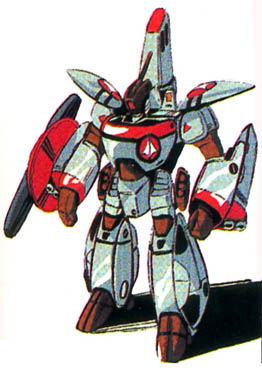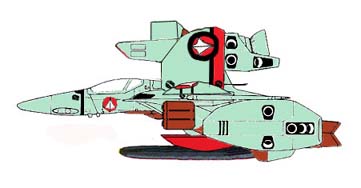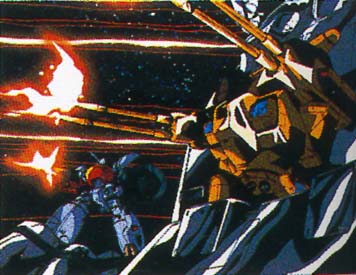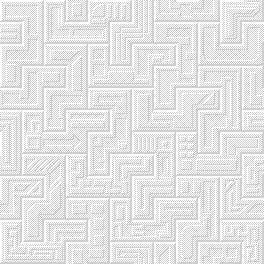VF-2 "JOTUN"
-
RPG Translation and Background by Kenneth Olson Kenneth
Olson
-
Macross Adaption by Kamikazi
-
Pictures by Robert Morgenstern
-
Background Information derived from Robotech
Technical Files
-
BACKGROUND
 One
of the more interesting variants that was developed, but little used, for
the Valkyrie was known as the "Jotun Valkyrie". This modular attachment
package design combined the motivating design paramaters for the older
Armored Valkyrie with components first designed on the Super Valkyrie,
as an attempt to create a more heavily armored Battloid with most of the
mobility advantages of the Super Valkyrie's boosters and its retained transformation
capability. It was thought that the Jotun Valkyrie would overcome the shortcomings
of the Armored Valkyrie with its increased mission flexibility, and could
serve to help fill the dwindling ranks of the Destroid defense contingent
as a highly-mobile point-defender. At the same time, it was thought that
the Jotun would make an excellent compromise between armor and acceleration,
which might make it more useful than the Super Valkyrie on certain types
of missions.
One
of the more interesting variants that was developed, but little used, for
the Valkyrie was known as the "Jotun Valkyrie". This modular attachment
package design combined the motivating design paramaters for the older
Armored Valkyrie with components first designed on the Super Valkyrie,
as an attempt to create a more heavily armored Battloid with most of the
mobility advantages of the Super Valkyrie's boosters and its retained transformation
capability. It was thought that the Jotun Valkyrie would overcome the shortcomings
of the Armored Valkyrie with its increased mission flexibility, and could
serve to help fill the dwindling ranks of the Destroid defense contingent
as a highly-mobile point-defender. At the same time, it was thought that
the Jotun would make an excellent compromise between armor and acceleration,
which might make it more useful than the Super Valkyrie on certain types
of missions.
After several months of fighting the Zentran, UN Spacy weapons specialists
on board the SDF-01 came to the realization that the VF-1, although an
extremely maneuverable mecha, was not nearly armed nor armored enough to
survive conflicts with the more numerous Zentran forces. The first
attempt to upgrade the basic VF-1 design (or the armored variant) functioned
as promised however the additional armor and missile load severely decreased
mobility. They decided in early 2010 to create more advanced design
which would retain the weaponry and armor advantage of the initial armored
Veritech while maintaining the maneuverability of the standard VF-1.
Although, the total internal missile payload of the VF-2 was less than
the Super VF (36 for the VF-2 verse 38 for the super), the number of missiles
was still a vast improvement over the standard VF-1. Two hip mounted
MM-3 missiles were added. Each launcher was capable of rotating 180
degrees providing the VF-2 protection from the rear when in battloid mode.
Two NP-AR-02 missile launchers were added under each arm. These launchers
had an increased payload of six missiles per launcher verses the NP-AR-01
found on the super VF with only three. In order to offset the massive
increase in weight a NP-BP-01C booster/missile launcher was taken
from the super valkyrie design and added to the rear providing additional
maneuverability along with sixteen short range missiles. Two NP-FP-01 fuel
and thruster packs were built in as part of the basic structure. On the
right arm an anti-projectile shield was added. A carbine version of the
PB-11, normally mounted on the Tomahawk, was placed on top of the shield
to replace the venerable GU-11 55mm gun pod.
Unlike the Armored Valkyrie, the Jotun Valkyrie was designed to be able
to transform without impacting its weapons load. The transformed mecha
had only about 58% of the maximum thrust (and only about 65% of the thrust:weight
ratio) of the Super Valkyrie, but because of the limited fuel storage in
the booster pod compared to the leg tanks, almost 90% of the delta-v. Moreover,
its thrust was thought to be more controllable by the average pilot than
the extraordinary power of the Super Valkyrie. As with the Super Valkyrie,
the Jotun Valkyrie was capable of ejecting all its external modules, leaving
it in the standard Valkyrie configuration.
The VF-2 proved to be extremely adept in space combat.
Some 10 units were built before the Zentran Assault on the Earth in July
2012. They were assigned mainly as defensive units guarding the SDF-01
and allied ships while the more numerous and maneuverable VF-1 Super Valkyries
were sent out with Reaction weaponry to knock out enemy ships and large
groups of mecha. The VF-2 groups took heavy casualties during the battle
often outnumbered 50 to 1. Only three of the original ten VF-2s survived
the battle. In the five years preceding the end of Space War 1, 150
VF-2 were produced. These units were placed on board the surviving
ARMD space platforms protecting the earth from any space born threats.
The development of the VF-4
Lightning III signalled the death of the Jotun Valkyrie. With Super
Valkyries already in service, with the brand-new Strike
Valkyrie offering equivalent cannon armament on an otherwise off-the-shelf
package, the value of additional armor still under debate, and a replacement
mecha already in the testing phases, the Jotun Valkyrie phased out of service.
Service History:
VF-2: Served with the UN Spacy from 2011 until 2022.
RPG STATS
-
Vehicle Type: VF-2 Jotun
-
Class: Variable Assault Fighter
Manufacturer: Stonewell Bellcom and Shinnakasu Industries
Crew: One pilot wearing Tactical Life Support System.
MDC BY LOCATION:
| Location |
Jotun |
| Head Lasers |
25 |
| * Head |
75 |
| Hands (2) |
30 |
| Arms (2) |
100 |
| Shoulders (2) |
75 |
| PB-11 |
50 |
| Arm Shield |
200 |
| Legs/Engine Thrusters (2) |
200 |
| ** Main Body |
300 |
| Reinforced Pilots Compartment |
200 |
| Retractable Utility Arms (3) |
3 |
| Wings (2) |
100 |
| GU-11 |
100 |

NOTES:
-
* Destroying the sensor head of the Jotun will knock out the mecha's major
sensor systems, including all of the optics systems (infrared, nightvision,
thermal). Radar and communications will be unaffected.
-
** Depleting the MDC of the main body will destroy the mecha.
SPEEDS:
-
RUNNING, SOLDIER CONFIGURATION:
-
160 kph
-
LEAPING, SOLDIER CONFIGURATION:
-
50 ft (15 m) high or 70 ft (21 m) long without thrusters.
-
FLYING, SOLDIER CONFIGURATION:
-
300 kph
-
FLYING, GERWALK/SOLDIER CONFIGURATION:
-
Mach One (670 mph/1072 kmph) maximum speed limit in an Earth-like atmosphere.
Can also hover in place indefinitely.
-
FLYING, FIGHTER CONFIGURATION:
-
Max level speed at sea level : Mach 1.0. Mach 2.71+ (1816 mph/1135 kmph)
max speed above 10,000 meters. Max altitude of 30,000 meters without rocket
booster assistance.
note: The VF-2 was used exclusively in space
born operations
POWER PLANT:
-
Two Shinnakasu/P&W/Roice FF-2001 thermonuclear turbine engines:
total engine output 256 kN total at max. power; 503 kN are available with
overboost. Exhaust nozzles allow for vector thrust, serving in place of
conventional elevators. System includes two reverse-vernier thrusters,
on blisters outboard of each intake; exhaust comes directly from main turbine
at a maximum of 20% thrust.
-
Four Shinnakasu NBS-1 high-thrust vernier thrusters, one on the
ventral in fighter mode, three in the 'backpack' in
Guardian and Battloid modes.
-
Pratt and Wittney - EF-2001 booster engines in the FAST pack, capable
of a total of 2354 kN of thrust. Total propellant capacity 11,000 kg in
FAST pack and CTB-04 conformal fuel tanks on legs.
STATISTICAL DATA:
-
HEIGHT:
-
15.4m in soldier configuration.
-
10.8 m in gerwalk configuration.
-
5.0 m in fighter configuration.
-
WIDTH:
-
8.6m at shoulders in soldier and gerwalk configuration.
-
14.8m with wings at maximum extension.
-
LENGTH:
-
5.0m in soldier configuration.
-
11.3m in gerwalk configuration.
-
14.0m in fighter configuration.
-
WEIGHT:
-
25,000 kg empty.
-
PHYSICAL STRENGTH:
-
Equal to a P.S. of 60
-
CARGO:
-
Small compartment behind pilot's seat for personal belongings
-
COMPATIBLE FAST PACKS:
-
None

WEAPON SYSTEMS:
1. MAUSER PBC-11C CARBINE PARTICLE BEAM CANNON :
The VF-2 GU-11 was replaced with a carbine
version of the PB-11 found on
the Tomahawk. The weapon is able to fire 15 MJ bursts up to 30 times
per minute at a
range of 5 kilometers.
-
PRIMARY PURPOSE: Assault
-
SECONDARY PURPOSE: Anti-Mecha
-
RANGE: 5,000 m
-
DAMAGE: 1D6x10 MD for each shot
-
RATE OF FIRE: 7 times per melee
-
PAYLOAD: Unlimited
2. MAUSER RoV-20 LASER CANNON: The
standard RoV-20 head laser was kept for the VF-2; however, all
models have only a single
weapon mounted on the top of the head. This was done to keep the
total power requirements
low enough that only a moderate
increase in power from the protoculture energizer was needed over the standard
VF-1
-
PRIMARY PURPOSE: Anti-missile
-
SECONDARY PURPOSE: Assault
-
RANGE: 600 m
-
DAMAGE: 2d6 MD for each single shot
-
RATE OF FIRE: Single shots equal to the combined attacks of the
pilot up to eight times per melee.
-
PAYLOAD: Conditionally unlimited.
3. HMMP-02 MISSILE LAUNCHER:
A single HMMP-02 missile system from the super veritech was added to the
rear of the mecha.
Only a single system was included because of the difficulties that arose
when the additional armor.
-
PRIMARY PURPOSE: Assault/Defense
-
SECONDARY PURPOSE: Anti-mecha
-
RANGE: Varies
-
DAMAGE: Varies
-
RATE OF FIRE: One at a time or in volleys of 2, 3 or 4
-
PAYLOAD: 16 short range missiles
4. 2x NP-AR-02: Mounted on either
arm are two modified versions of the NP-AR-01 found on the super veritech.
Each
launcher can hold
6 short range missiles instead of the standard three found on the Super
Valkyrie
-
PRIMARY PURPOSE: Assault/Defense
-
SECONDARY PURPOSE: Anti-mecha
-
RANGE: Varies
-
DAMAGE: Varies
-
RATE OF FIRE: One at a time or in volleys of 2, 3, or 4
-
PAYLOAD: 6 short range missiles per launcher
5. 2 x MM-3 MULTIMISSILE SYSTEM:
Mounted on either ship are two MM-3 missile systems. Each launcher
can
rotate 180 degrees.
This allows the VF-2 to fire missiles towards the rear in battloid mode
if necessary.
-
PRIMARY PURPOSE: Anti-missile
-
SECONDARY PURPOSE: Assault
-
RANGE: Varies
-
DAMAGE: Varies
-
RATE OF FIRE: One at a time or in volleys of 2, or 3, or all six
-
PAYLOAD: 3 short range missiles per launcher

6. BODY/WING HARD POINTS: Each wing
of the VF-2 has three hardpoints on it for holding
missiles and other
armaments. Each hardpoint can hold one long-range missile or three medium
range missiles (and
other armaments are possible).
-
PRIMARY PURPOSE: Assault/Defense
-
MISSILE TYPES: Any type of Medium
Range or Long
Range Missile can be used.
-
RANGE: Varies with missile type.
-
DAMAGE: Varies with missile type.
-
RATE OF FIRE: 1 at a time or volleys of up to 6/18 (all) missiles.
-
PAYLOAD: Up to 6 long-range missiles or 18 medium-range missiles.
7. HAND TO HAND COMBAT: If necessary,
the Jotun can engage in melee combat rather than use a weapon. The
VF-2 is extremely
agile and can execute most typical hand to hand combat moves, such as punches,
jump kicks, leap
attacks, rolling with
impacts, etc.
DAMAGE:
-
Restrained Punch: 1D4 M.D.
-
Full Strength Punch: 2D6 M.D.
-
"Booster" Punch: 3D6 M.D. (counts as two attacks)
-
Tear or Pry with Hands: 1D6 M.D.
-
Kick: 1D6 M.D.
-
Leap Kick: 2D6 M.D.
-
Body Flip/Throw: 1D4 M.D.
-
Body Block/Tackle: 1D6 M.D.
-
Stomp: 1D6 M.D. (only effective against small objects)
STANDARD EQUIPMENT FOR THE VF-2 JOTUN:
-
AUTO-PILOT: The Jotun is equipped with a computerized auto-pilot,
allowing the pilot to relax or even sleep during long voyages. The auto-
pilot can be programmed with a single destination or a complex flight plan
involving multiple speeds, directions, and destinations. The onboard computer
will alert the pilot when the fighter is near its destination, and can
also be set to automatically signal when sensors detect objects near the
mecha. The auto-pilot was designed with long intra-system space journeys
in mind.
-
COMBAT COMPUTER: The combat computer tracks and identifies specific
enemy targets, and has a database of over 10,000 images stored in memory.
The computer can identify and track up to 250 targets simultaneously.
-
EXTERNAL AUDIO PICKUP: Range: 300 ft (91.5 m). A sound amplification
system that can pick up normal conversation up to 300 feet away.
-
HEAT AND RADIATION SHIELDS: Special shielding prevents the penetration
of life threatening head and radiation. A radiation detection and alarm
system are linked with the shields and will sound an alarm if there is
a rupture in the shields and what the levels of radiation are.
-
HOMING SIGNAL: The escape pod of the VF-2 is equipped
with a homing device that enables rescue teams to locate a disabled craft
or ejected life pod. The range of the signal is 400 miles (640 km). Most
RDF ships and veritechs can locate and track a homing signal, and the onboard
computers will automatically notify their pilots if such a signal is detected.
-
THOMSON LT-3 LASER TARGETING SYSTEM: Range: 100 miles (160 km).
Used for increased accuracy in the striking of enemy targets and is partly
responsible for the mecha's strike bonus.
-
LOUDSPEAKER: A loudspeaker system is built into the craft, which
can be used to amplify the pilot's voice up to 90 decibels.
-
OPTICS: INFRARED: Range: 2000 feet (610 m). This optical system
projects a beam of infrared light that is invisible to the normal eye,
but detectable by the mecha's sensors. The system allows the pilot to detect
hidden/concealed objects by their IR reflectiveness. The beam will be visible
to anyone with IR sensitive optics, however.
-
OPTICS: NIGHTVISION: Range: 2000 feet (610 m). A passive light image
intensifier that emits no light of its own, but relies on ambient light
which is electronically amplified to produce a visible picture.
-
ZEISS TS-2 OPTICS: THERMAL IMAGER: Range: 2000 feet (610 m). A passive
optical heat sensor that detects infrared radiation projected by warm objects
and converts that data into a false-color visible image. The system enables
the pilot to see in the dark, in shadows, and through smoke, and also adds
a +10% bonus to pilots using a tracking skill.
-
HUGHES AWG-20 RADAR: X-band pulse Doppler radar with 100 mile range.
-
RADIO/VIDEO COMMUNICATION: Long range, directional communications
system with satellite relay capabilities. Range: 600 miles (960 km) or
can be boosted indefinitely via satellite relay.
-
SELF-DESTRUCT: To prevent capture of an advance variable fighter
by the enemy, the pilot can activate the VF-2 self-destruct system, which
will cause the fighter to explode after a delay of up to 60 minutes (time
is set by the pilot). The explosive damage is contained within a 20 foot
(6 m) area and inflicts 1D6x10 M.D. to everything within the radius of
the explosion. All internal systems are obliterated. The escape pod will
be automatically ejected prior to the explosion unless the pilot overrides
the ejection sequence.
-
STANDARD SURVIVAL KIT: All UN Spacy Variable Fighters come equipped
with a portable survival kit. Inside the small reinforced box is a medium-sized
flashlight, two hand flares, one rocket flare, a compass, infrared distancing
binoculars, a small mirror, a pocket knife, dehydrated and concentrated
food (can be stretched into a five day supply for one person) and basic
first aid items (aspirin, bandages, disinfectants, etc.)
-
TACTICAL LIFE SUPPORT SYSTEM: The Jotun's cockpit is pressurized,
and also provides additional air feeds to the pilot's flight suit that
provides him with pressurized breathing. The flight suit also contains
an upper and lower g-suit that promotes blood circulation even during high-g
turns, thus decreasing the possibility of pilot's blacking out in combat.
COMBAT BONUSES FOR JOTUN TRAINING:
BASIC VALKYRIE COMBAT TRAINING
-
Basic training for non-pilot military personnel.
-
1 attack per melee (plus those of the pilot).
-
Add one additional action/attack at levels three, nine, and fifteen.
-
+1 to strike.
-
+1 to parry
-
+1 to dodge in soldier mode, +2 in gerwalk, +4 in jet mode.
-
+1 to roll with a punch or fall with an impact, reducing damage by half.
-
Critical strike same as pilot's hand-to-hand.
-
Body block/tackle/ram - 1D6 M.D. plus a 50% chance of knocking an opponent
down, causing him to loose initiative and one attack that melee round.
ADVANCED VALKYRIE COMBAT TRAINING
-
Advanced training for military pilots and mecha specialists.
-
3 attacks per melee (plus those of the pilot).
-
Add one additional action/attack at levels three, six, eleven, and fifteen.
-
+1 on initiative.
-
+2 to strike
-
+3 to parry
-
+2 to dodge in solder mode, +5 in gerwalk, +7 in jet mode.
-
+3 to roll with a punch or fall with an impact, reducing damage by half.
-
Critical strike same as pilot's hand-to-hand.
-
Body block/tackle/ram - 1D6 M.D. plus a 50% chance of knocking an opponent
down, causing him to loose initiative and one attack that melee round.
REFERENCES USED IN THIS DESIGN

 One
of the more interesting variants that was developed, but little used, for
the Valkyrie was known as the "Jotun Valkyrie". This modular attachment
package design combined the motivating design paramaters for the older
Armored Valkyrie with components first designed on the Super Valkyrie,
as an attempt to create a more heavily armored Battloid with most of the
mobility advantages of the Super Valkyrie's boosters and its retained transformation
capability. It was thought that the Jotun Valkyrie would overcome the shortcomings
of the Armored Valkyrie with its increased mission flexibility, and could
serve to help fill the dwindling ranks of the Destroid defense contingent
as a highly-mobile point-defender. At the same time, it was thought that
the Jotun would make an excellent compromise between armor and acceleration,
which might make it more useful than the Super Valkyrie on certain types
of missions.
One
of the more interesting variants that was developed, but little used, for
the Valkyrie was known as the "Jotun Valkyrie". This modular attachment
package design combined the motivating design paramaters for the older
Armored Valkyrie with components first designed on the Super Valkyrie,
as an attempt to create a more heavily armored Battloid with most of the
mobility advantages of the Super Valkyrie's boosters and its retained transformation
capability. It was thought that the Jotun Valkyrie would overcome the shortcomings
of the Armored Valkyrie with its increased mission flexibility, and could
serve to help fill the dwindling ranks of the Destroid defense contingent
as a highly-mobile point-defender. At the same time, it was thought that
the Jotun would make an excellent compromise between armor and acceleration,
which might make it more useful than the Super Valkyrie on certain types
of missions.

